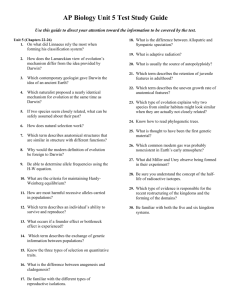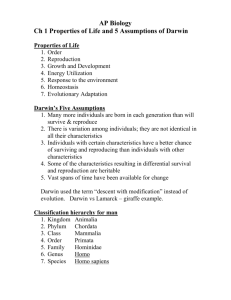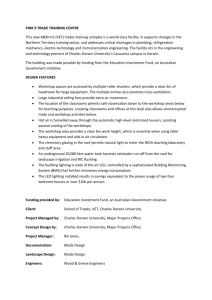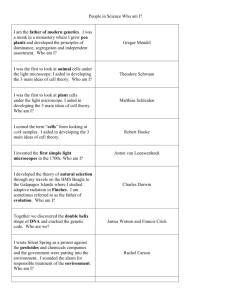Darwin's Dangerous Idea
advertisement
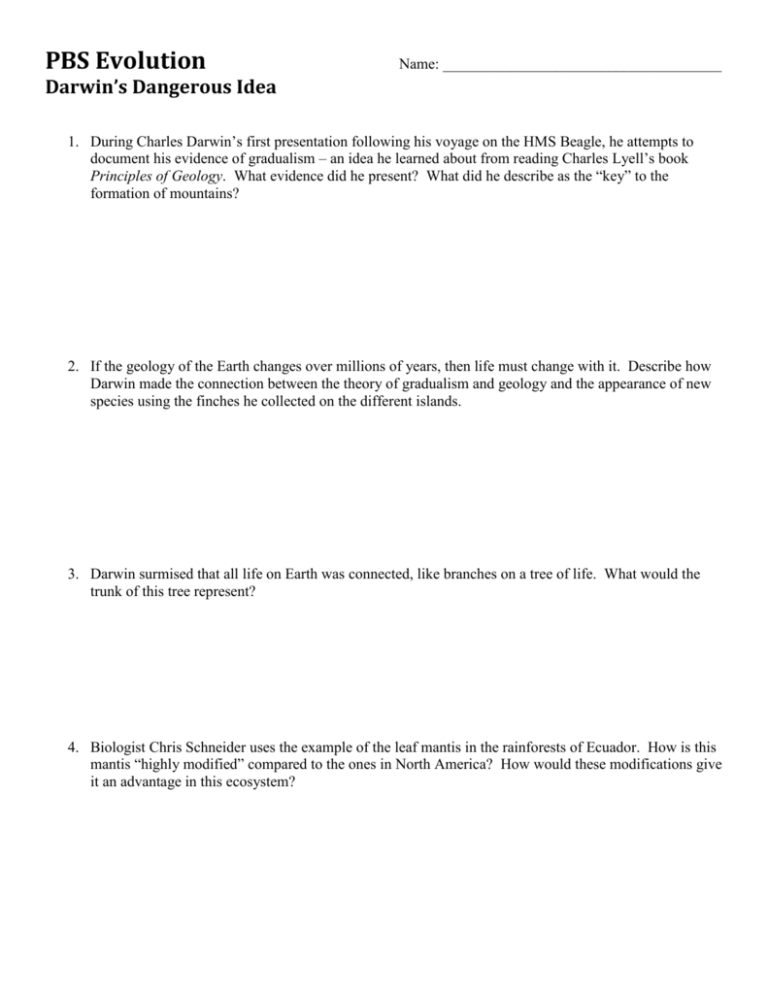
PBS Evolution Name: _____________________________________ Darwin’s Dangerous Idea 1. During Charles Darwin’s first presentation following his voyage on the HMS Beagle, he attempts to document his evidence of gradualism – an idea he learned about from reading Charles Lyell’s book Principles of Geology. What evidence did he present? What did he describe as the “key” to the formation of mountains? 2. If the geology of the Earth changes over millions of years, then life must change with it. Describe how Darwin made the connection between the theory of gradualism and geology and the appearance of new species using the finches he collected on the different islands. 3. Darwin surmised that all life on Earth was connected, like branches on a tree of life. What would the trunk of this tree represent? 4. Biologist Chris Schneider uses the example of the leaf mantis in the rainforests of Ecuador. How is this mantis “highly modified” compared to the ones in North America? How would these modifications give it an advantage in this ecosystem? 5. Describe the differences in climate between the low-lying rainforest and the high-elevation grasslands near the Andes Mountains. What kinds of adaptations have the scientists found in hummingbirds that have allowed them to colonize these different ecosystems? 6. At what point are two closely related organisms (such as the hummingbirds) considered separate species? 7. What tool do biologists now have to compare species that Darwin did not? Using this tool, how long ago did the highland and lowland hummingbirds diverge? 8. Charles Darwin attempts to relate his theory to his cousin Emma Wedgwood, using the selective breeding of dogs as an example. What problem does Emma point out with his analogy? 9. After dinner with his brother, Charles Darwin looked through a book by Thomas Robert Malthus, who believed that humanity, if unchecked, could double its population size in 25 years. Why then, wasn’t the Earth overrun with humans at this point? How does this relate to the stoning of the Darwins’ carriage? 10. Describe the theory of natural selection, using the ideas of individual variation, limited resources, and reproduction. 11. At the time of this documentary, 19 drugs for HIV were available. Explain then, using the theory of natural selection, why AIDS could not be cured. How does the speed of change in viruses compare to animals? 12. Explain how having a patient temporarily stop taking drugs can help combat the emergence of drug resistant viruses. 13. Richard Owen showed Darwin sketches of several different animal skeletons. What did both scientists find striking about their structure? Describe both Owen and Darwin’s explanation for this observation. 14. The eye was cited by many as a “perfect” organ – evidence that the hand of God must have guided the creation of man. How is the eye actually imperfect, and why are these imperfections important to understanding its evolution? 15. The documentary presents a series of possible “intermediary steps” in the formation of a complex eye organ. Explain why natural selection would favor each of these changes, and give an example of a modern organism that still relies on that design. a. Cup-shaped vision organ, compared to the primitive flat patch of sensory cells. b. Constricted eye openings. c. A clear convex lens in front of the opening. 16. The publication of the book On the Origin of Species drew a lot of controversy towards Darwin and Thomas Henry Huxley, mostly for the suggestion that humans arose by the same natural laws as all other animals. What was the main piece of evidence used against this theory by Bishop Wilberforce and Richard Owen? How did Huxley counter this argument?


